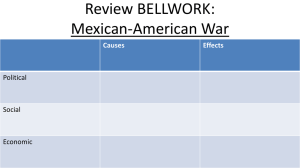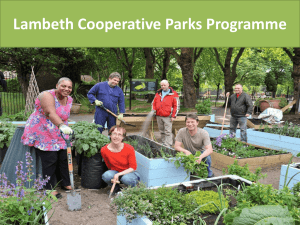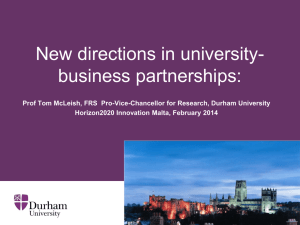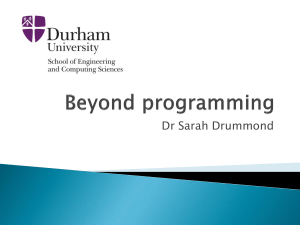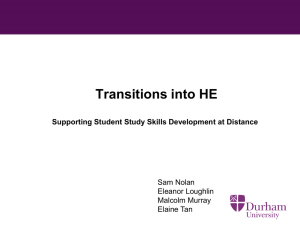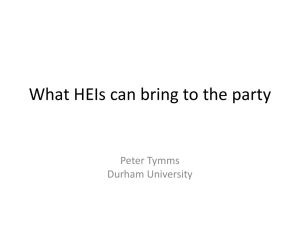More than Parks_Final Presentation to Council
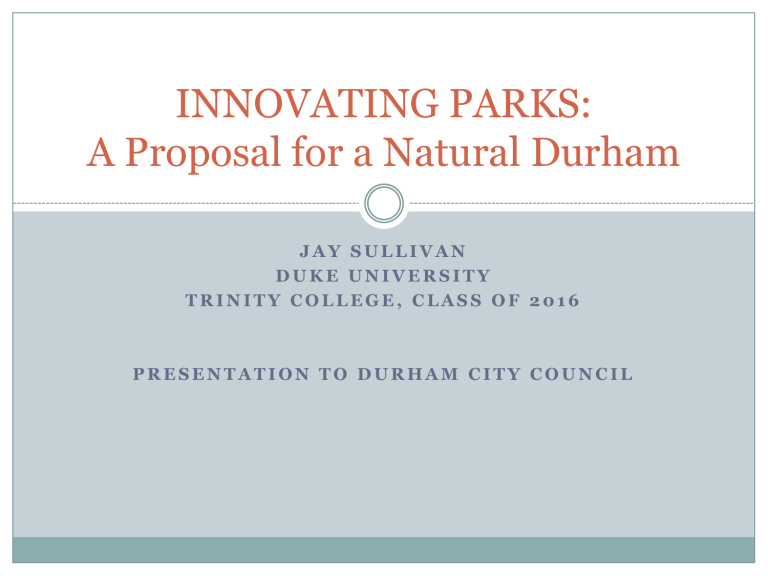
INNOVATING PARKS:
A Proposal for a Natural Durham
J A Y S U L L I V A N
D U K E U N I V E R S I T Y
T R I N I T Y C O L L E G E , C L A S S O F 2 0 1 6
P R E S E N T A T I O N T O D U R H A M C I T Y C O U N C I L
Introduction
Current state of Durham parks and urban planning
What can the future be?
Academic research for design and planning
Case Study, Example of a park development
A Complete System-Not Just Parks
Application of principles-Accomplish the goals
Current Approaches to Parks
Penny on tax rate to build and maintain parks and trails, make it a priority of city
Recreational, open spaces
Green Infrastructure-making connections
Enhance natural capacities when possible, more minimization
What is Urban Environmental Design (UED)?
Evidence-based creative protection and enhancement of natural systems to provide for the health of humans and preserve ecosystems-Schauman, 2013
Structure, but unstructured and innovative
The Soul of Durham Parks
The Problem
Durham does not have the capacity or focus on innovative park spaces that serve multiple purposes, and concepts for parks do not easily translate to broader urban planning
The Solution
Parks cannot be controlled - Hubs of life
Public spaces – Design communities around green spaces with parks as both natural ecosystems and community centers
Increase maintenance, equal access to parks (natural benefits to having many with good design principles)
Ecological Democracy and Sustainable Design
Randolph T. Hester writes in his book, Design for Ecological
Democracy, in such a society:
"Actions are guided by understanding natural processes and social relationships within our locality and the larger environmental context. This causes us to creatively reassess individual needs, happiness, and long-term community goods in the places we inhabit. Ecological democracy can change the form that our cities take creating a new urban ecology. In turn, the form of our cities, from the shape of regional watersheds to a bench at a post office, can help build ecological democracy"
(4).
Humans and Nature
“Biophilia is the innate tendency to focus on life and lifelike process.” E.O. Wilson--Harvard 1984
Emotional, spiritual, and neurological connection
Environmental psychology (sense of home, exploration, complexity, and coherence in natural spaces) Rachel and
Stephen Kaplan U/Michigan
Life demands directed attention (higher stress less health), but nature solves that by providing relief
Biophilia, prospect (strength) refuge (hide) and hazard
(danger)
Biophilic Design
Multifaceted Parks - A human and environment element
Biophilic Design creates a good habitat for people in a modern built environment that satisfies the need for beneficial contact with the world and enhances the natural environment
Connection to nature
We need to feel, touch, and explore
We care more for the sustainability of the planet when we have something to value and protect
Applied Biophilic Design
Integrate with widespread action
Benefits to City of Durham
More than Durham Central Park
Add more green, nearby nature, barriers such as highways destroy this
Need local parks and connectivity for fauna and humans
Benefits to citizens
Scientific evidence and educational opportunities
Neuroscience, immunology, sensory deprivation, social contact, and growth
Children mature in their world-epigenetics
Environmental Benefits
Connective park system provides habitat for local flora and fauna
Provides ecosystem for animals and ecosystem services for the community
Deal with storm water at the source, lack of necessity of pipes and shows water to people
Daylighting streams
Sun and air improve aquatic habitat, increase real estate value, reminds people of it, remove armored side slopes and increase roughness with vegetation, water purification-wetlands
Dye Creek-flashy streams that flood and not at equilibrium) Trinity Homestead and Wall Town
Consistent symptoms of the “urban stream syndrome” include a flashier hydrograph, elevated concentrations of nutrients and contaminants, altered channel morphology and stability, and reduced biotic richness, with increased dominance of tolerant species (Paul and Meyer, 2001, Meyer et al. 2005). Jrnl of North
American Benthological Society, vol 24, #3 [sept 2005] pp 706-723.
Burlington, Vermont
The Green Machine-Storm Water Management
Pervious surfaces, constructed wetlands (green streets leach pollutants/reduce runoff and green the city streets clean at source and create habitat), Green Roof
Constructed wetlands, waste and storm water treatment - on site or at crucial water locations
Urban Greening
Sidewalks as water treatment
Need to let things grow for urban wildlife, beautiful engineering develops urban habitat for animals and people
Case Study: 220 E. Main St.
Adaptive Reuse-An example people can learn from and develop values toward
Case Study: 220 E. Main St.
Evaluating Durham Parks Master Plan
Extend principles of greenery and environmental services to planning and execution of urban spaces
Connectivity and equal access for all
Increase access by developing community parks that serve connective and local access services-humans and nature
Focus on mitigating recreational/athletic space development while enhancing other resources
Use roofs, walls, and sidewalks/swales to create ecosystems
Green infrastructure must be a priority in the
Durham urban landscape
It will be well received, if executed with UED principles
Engage the Public and Promote Stewardship
How to engage public to make it happen
Parks4Durham
Get citizens involved in planning and execution process
Develop capacity for Green Durham
Ecological democracy
Equity of Access and Voice in City Decisions
Planning that builds communities and build environmental capability
Urban Environmental Design Principles
Biophilic cities model-Features of city connect to nature
Parks integral to extensive efforts in the community
Create a city that is livable for people
Vision for the Future
A Bright Future, a Green Durham
References
City of Durham Parks and Recreation Master Plan 2013
Durham Trails and Greenways Master Plan
Central Durham Gateways Plan
Downtown Durham Master Plan
Design for Ecological Democracy, Randolph T. Hester
Urban Transformation, Ian Bentley
Sustainable Urbanism: Urban Design with Nature, Douglas
Farr
Biophilic Design: The Architecture of Life, Stephen Kellert
Lecture and Class Notes from ENV 253: Urban
Environmental Design course at Duke University
